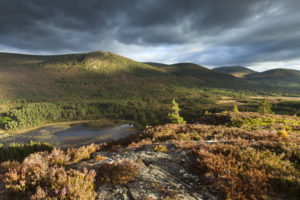Land ownership in Scotland is a tricky subject, with the classic figure “432 people own more than half the country†guaranteed to leave most reasonable folk envisaging the tweed-clad ruling class and hankering after change.
It’s a useful number in summing up many of the wrongs of what I call the Big Land system, but the truth, of course, is far more complicated than that: an awful lot of the land they own is economically useless hill and bog, and I suspect conservation NGOs and even community owners are among the 432 “peopleâ€.

(Do the maths: for instance the Knoydart Foundation community owner has 44,000 acres, about 0.2% of the whole of Scotland, and if 432 owners had 0.2% each they’d own 95% of the land; so they’re a player, as will be other community land groups, the John Muir Trust, and the National Trust for Scotland. Unless, of course, I have made some order-of-magnitude error and my sums are way out…)
Anyway, leaving my geekery and dodgy maths behind, I was interested in a couple of mentions of land ownership at last weekend’s conference on rewilding at Stirling University, organised by Scotland: The Big Picture.
It was a fascinating event, with great speakers, including old friends such as Nick Underdown from Open Seas, outdoor education guru Peter Higgins, and Ian Mackenzie of Scottish Wildlife Trust, plus the charismatic American rewilder, Sean Gerrity. One point many emphasised was the importance of people in the “rewilded” landscape, giving the lie to the idea that rewilding is about parkifying or de-peopling.
Franz Schepers from the Rewilding Europe umbrella group stood out as giving us a very different perspective. Over there, on the mainland we’re about to become even more disconnected from, they’re bringing back large herbivores of the sort that cause us so many problems here in Scotland, because their woods are growing too well. I could see Steve Micklewright of Trees for Life going slightly green as he listened to that one.
It tells us that getting the balance right is not that simple, but Franz went on to make another very practical point. He was talking about rewilding in Portugal, including the Greater Coa Valley , and mentioned how hard it is to get the hundreds of small farmers, some of whom only have a hectare or two, on board.
He looked enviously at Scotland’s much derided land-ownership situation: get one laird with 44,000 acres on board and you’ve gone a long way towards rewilding a whole river catchment.
I guess there are two ways of getting landowners into with rewilding: make it pay or tug at their green heart-strings. Incentives to grow trees, cull herbivores, or tolerate carnivores can work; in Scotland’s case, kind-hearted environmentalist billionaires who have bought into rewilding are proving very useful.
Another speaker on Saturday was Jeremy Roberts from the Cairngorms Connect project, who is building a wildlife and woodland corridor across around 150,000 acres of the beautiful mountain and forest landscape on the great northern apron of the range.
A very big part of that 150,000 acres belongs to Anders Hoch Povlsen, the Danish billionaire whose holdings centre on the alpine and imposing Glen Feshie.
There’s an old saying in conservation: Grab it when you can, ’cos there’s not a lot of it about. Actually I just made that up, but it is what conservationists have to do, and by connecting up the Povlsen land with NGO and Government estates, Roberts and his team are taking a pragmatic approach. Povlsen has already proved that, whatever you think of him as Scotland’s biggest landowner, conservation is a major concern, and his wingman in Scotland, Thomas MacDonnell, has a great reputation for pushing the conservation agenda and being one of the good guys.
Roberts, who also gets other philanthropic cash, told the conference: “That funding, that support, is vital to us.â€
The idea that we’re dependent on handouts at the whim of the wealthy to improve our environment will stick in the craw of many of us, and perhaps in the longer term a growth in community land can change things, but for now pragmatism dictates that Big Land in the shape of the rich is part of the answer to our environmental problems, in the short-to-medium term, at least.